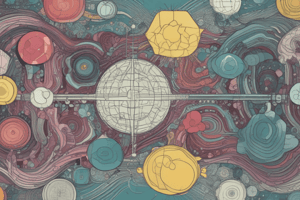Podcast
Questions and Answers
What type of research design is used in 'Correlation'?
What type of research design is used in 'Correlation'?
Correlational Research Designs
What is the main focus of the research design 'Correlation'?
What is the main focus of the research design 'Correlation'?
To explore and analyze the relationship between two or more variables.
What is the alternative phrase for 'Variable X'?
What is the alternative phrase for 'Variable X'?
Predictor Variable
Correlation research designs can infer causation.
Correlation research designs can infer causation.
Which of the following is NOT a valid term for use in correlation research?
Which of the following is NOT a valid term for use in correlation research?
A perfect positive correlation is represented by r calc = +1.
A perfect positive correlation is represented by r calc = +1.
A 'r calc' value of 0 indicates a strong negative correlation.
A 'r calc' value of 0 indicates a strong negative correlation.
'Pearson's r' is used for analyzing quantitative dependent variables including interval and ratio.
'Pearson's r' is used for analyzing quantitative dependent variables including interval and ratio.
Spearman Rank Order Correlation Coefficient is used for analyzing quantitative dependent variables.
Spearman Rank Order Correlation Coefficient is used for analyzing quantitative dependent variables.
What type of research design is 'Simple Linear Regression'?
What type of research design is 'Simple Linear Regression'?
What is the goal of Simple Linear Regression?
What is the goal of Simple Linear Regression?
Flashcards
Correlation
Correlation
A statistical relationship between two variables, showing how they tend to change together, but not implying causation.
Positive Correlation
Positive Correlation
As one variable increases, the other variable tends to increase as well.
Negative Correlation
Negative Correlation
As one variable increases, the other variable tends to decrease.
Correlation Coefficient (r)
Correlation Coefficient (r)
Signup and view all the flashcards
Perfect Positive Correlation
Perfect Positive Correlation
Signup and view all the flashcards
Perfect Negative Correlation
Perfect Negative Correlation
Signup and view all the flashcards
No Correlation
No Correlation
Signup and view all the flashcards
Causation vs. Correlation
Causation vs. Correlation
Signup and view all the flashcards
Pearson's r
Pearson's r
Signup and view all the flashcards
Spearman Rank Order Correlation
Spearman Rank Order Correlation
Signup and view all the flashcards
Simple Linear Regression
Simple Linear Regression
Signup and view all the flashcards
Dependent Variable
Dependent Variable
Signup and view all the flashcards
Predictor Variable
Predictor Variable
Signup and view all the flashcards
Scatterplot
Scatterplot
Signup and view all the flashcards
Regression Line
Regression Line
Signup and view all the flashcards
Linear Regression Formula
Linear Regression Formula
Signup and view all the flashcards
Slope (b)
Slope (b)
Signup and view all the flashcards
Y-intercept (a)
Y-intercept (a)
Signup and view all the flashcards
Study Notes
Correlation
- Correlational research designs explore relationships between variables.
- Correlation does not imply causation. There is no cause-and-effect relationship between variables.
- To explore the correlation between variables, graphs are often used (e.g. scatterplots).
- Scatterplots show the relationship between variables X and Y and their direction
Types of Correlation
- Positive Correlation: As one variable increases, the other variable tends to increase. Example: Increased hours of study may correlate with improvement in exam scores.
- Negative Correlation: As one variable increases, the other variable tends to decrease. Example: Increased time spent playing video games may correlate with decreased time spent on homework.
- No Correlation: No apparent relationship between variables. Example: No relationship between shoe size and intelligence.
Variables
- Variable X: One of the variables being examined for a relationship.
- Variable Y: Another variable being examined for a relationship.
- Variable Z (example): A third variable that might influence the relationship between X and Y. The relationship between X and Y could be correlated to Variable Z rather than to each other,
Statistical Assessments
- Pearson's r: A measure of the strength and direction of a linear relationship between two quantitative variables (interval or ratio).
- Spearman Rank Order Correlation Coefficient: A measure of the strength and direction of a relationship between two ordinal variables.
Simple Linear Regression
- Predicting values of a dependent variable based on a single predictor variable.
- The linear regression formula allows the researcher to determine a relationship that can be used for prediction.
- Example: predicting a student's final exam score, given the student's score from mid-term exam.
- Use a predictor variable (X) to predict a dependent variable (Y).
Data Visualization
- Scatterplots are used to visualize the relationship between two variables. The plot shows the data points as individual dots. The line connecting most data points illustrates the correlation.
Studying That Suits You
Use AI to generate personalized quizzes and flashcards to suit your learning preferences.




